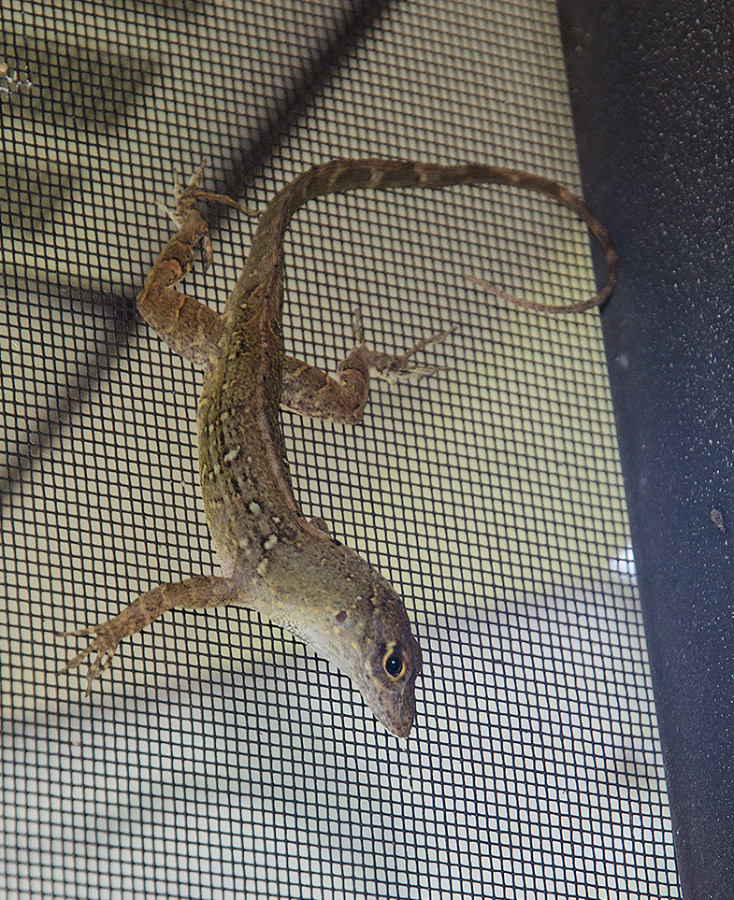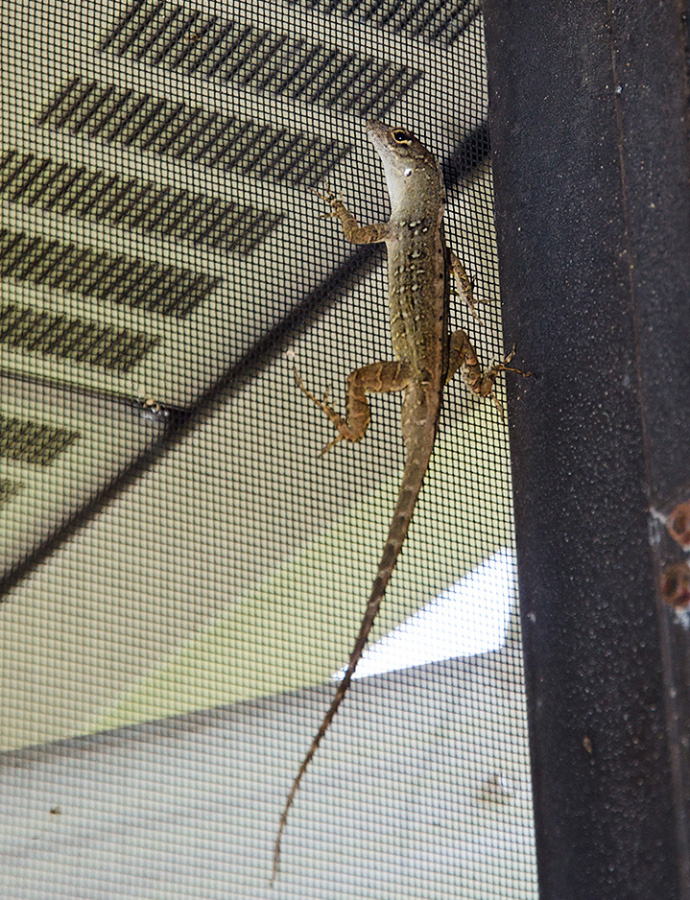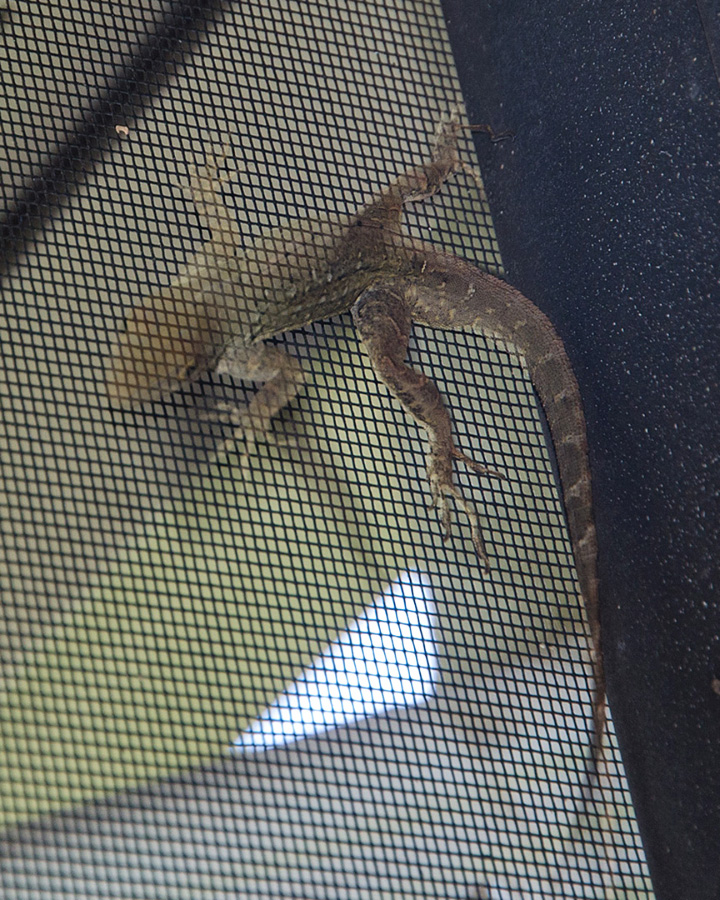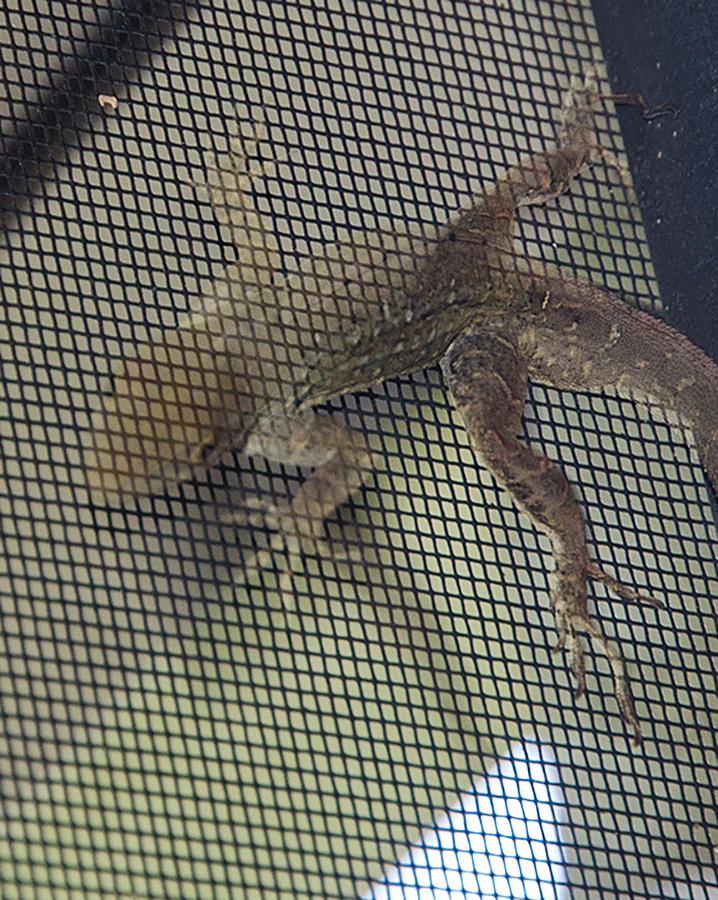In a comment on yesterday’s post I said that “everyone loves a mystery” but I like my mysteries best when they’re solved!
Yesterday blog reader Roger Burnard sent me yet another mystery and I’m stymied by it so we’re both hoping that someone out there can help us come up with an explanation. The images below belong to Roger and I use them here by permission. They were taken with a Nikon D7000 with attached Nikon 16-85mm lens. Techs were 1/60th sec, f/6.3, ISO 200, with flash turned on.
I’ll do my best to accurately paraphrase what Roger told me about the images and the enigma.

Roger photographed this anole on the back door of his lanai several years ago because a friend wanted to know what they looked like. In this first image everything looks as expected.

In the next image in the series everything looks normal too. The tail becomes more out of focus down it’s length but so does the door screen and both are to be expected given the angle and the techs.

But check out this next image in the series. The front part of the anole now appears to be behind the screen and the rest of the body in front of it. And sharp focus has been lost on the part of the anole that appears to be behind the screen.

A closer crop of the same image gives us a better look. I simply don’t understand how we can see screen that is, in reality, behind the anole where we shouldn’t be able to see it and that the effect fades in and out throughout the image. For those familiar with recent versions of Photoshop it’s almost as if the camera has used Content-Aware Fill to clone in the screen in front of the lizard. I’m sure that didn’t happen but I can’t for the life of me think of a rational explanation. Even a failing camera shutter mechanism couldn’t cause this effect as far as I know.
I realize that most of my readers are much more interested in nature photographs and bird behaviors than they are in photo-geekery but I also know that some of you are far more knowledgeable about the mechanics and physics of photography than I am so both Roger and I are hoping that someone will be able to shed some light on this little conundrum.
Besides I think that even non-photographers might be intrigued by this…
Back to more regular fare tomorrow…
Ron
PS – Happy Father’s Day to all you dads out there!


Well, I’m back from my morning of shooting. It didn’t turn out as I expected and the morning ended up being very stressful and potentially tragic for a juvenile Short-eared Owl. I’ll probably post more about that in the morning but for now I just want to thank everyone for their input and for providing your expertise in helping to solve this puzzle.
It appears to me that Brian, Neil and Ryan are probably on the right track. What they’re saying seems logical to me (at least to the point that I understand it all). I never use flash in my bird photography so I don’t know a lot about it but to me their theory seems logical.
I’m so grateful for all your feedback so far. I’m sure Roger is too. Thank you.
Hello Ron, Sorry I’m very late in the game on this conversation, but it does indeed look to me like the flash burst was much faster than the shutter setting (likely 1/100 or faster vs. 1/60) and so only partially “froze” the part of the anole that was moving very quickly, which I’m told they can do!
Neil is on the right track for sure. Fast moving subject, slow shutter speed and you end up with something like this. I would be curious to know/confirm a gut feeling the “rear curtain sync” was on for the flash. I also assume it was the on-board flash so it wouldn’t have the output of a hot shoe flash. Nikon’s “smart” flash mode sometimes think for you too much and seen it do weird crap like change curtain’s for some reason. (Here I would suspect the bright background.)
Normally your camera is on front curtain and once the flash fires the first curtain opens. In rear sync the flash doesn’t fire until the rear curtain is closing…a moment or two of ambient lights gets in then flash fires. See for a much better explanation and examples:
http://www.digital-photo-secrets.com/tip/3326/how-to-use-rear-curtain-flash-for-creative-photos/
Moiré wouldn’t explain this esp with the anti-aliasing filter. Being a Nikon rather than a Canon is also likely! 😉
It’s proof of why anoles move so fast. They can transport. 😀 It is obviously caught mid-shift. 😀
Great thought Arwen, of course the camera caught it in the midst of its transport! WOW!! what a camera when it can do that!!
LOL! Right? Now we all need to sit and watch lizards while doing burst photos. 😀
Strange, but cool effect!
Effectively, it’s a double exposure. The flash portion is roughly 1/5000 of a second which is a fraction of the 1/60th of a second total. In the first two images the Anole is stationary through the totality of the exposure, hence the sharp, no bleed through images. On the really cool motion shot, The anole has begun his movement just prior to the shutter release. The flash portion of the exposure had preserved the total outline sharply and 2/3 of the tail that remained on the door frame and the left rear leg were fairly stationary and act as a pivot point of the movement. The exposure of the near side door frame and tail above it are set by the flash. No back lighting.For the screen under the anole to register it has to be visible through part of the exposure in that area of the image. The florescent ceiling lights, only one showing in the image, help define the screen. The Anole was not in certain areas long enough to even register any exposure and only having light from behind, seems to disappear in those areas it rapidly moved across.
My 2 cents
Couldn’t do that on purpose if you tried! 🙂 Logical to me – thx for the explanation!
Thanks Neil, makes sense now!!
Might be teleportation, too!
An obvious case of teleportation ala Star wars…I knew it was bound to happen sometime soon…..the molecules of an object are electronically disassemlbled, projected to the target destination, then reassembled…as simple as that! What I find disturbing, is that anoles are apparently doing this before we humans are….Happy Father’s Day!!!
You clearly need a smart-alec answer to the puzzle (which is very intriguing): the lizard is in the process of transporting itself to the other side of the screen via science fiction methods…
Happy father’s day and happy shooting! Which reminds me, how is Shannon doing? I hope she’s experiencing complete recovery.
Susan, Shannon is still improving and though it continues to be a very slow recovery it’s truly amazing how far she has come – especially considering the fact that the ER doctors told the family on the night of the accident that she had “zero chance of survival”. She and her family will soon be moving out west again and I’m absolutely delighted about that because she’ll be very close to her mother and close enough to me that I’ll be able to visit her occasionally. Thank you for your concern.
I am thrilled to hear that Shannon continues to improve. Wonderful, wonderful news. And how nice to be able to prove doctor’s wrong. Too many of them believe that they are omnipotent.
That is GREAT NEWS!!!
This is why I don’t even try photography…it obviously leads to insanity amd I don’t need any push in that direction…am doing far too well on my own…..
Now that I’ve read several “explanations” and , as a non- photo geek I have no clue what they’re talking about, it remains a combination of magic and mystery…and blows my poor, little weak, feeble mind!!!
Your mind is not blown on its own. And isn’t magic and mystery a treat?
BrianG’s comment may be it also – like making walking people disappear from a scene with shutter speed.
I, too, would like to make (some) people disappear…how I wish I knew how to do it! Maybe if I sent their names to Roger’s friend…….
I’m sure the answer lies with photo “geekery”—-but it looks like MAGIC to me — loved seeing it !
I believe the D7000 doesn’t have an anti-aliasing filter. Other possibility is a reflection from somewhere tho that seems a bit remote. Curious and, actually, neat! 🙂
Ah-ha… I am thinking it is Moiré then…
I believe the D7000 does have the filter but the D7100 does not (I own both) so I doubt the Moire is the culprit. I like the flash timing issue better.
Happy Father’s Day Ron!
I am very interested to find out if someone out there has an idea as well.I haven’t a clue, but I certainly would like to know.
By the way those first two are good shots!
Interesting, maybe a case of focus?
Charlotte
I believe this is due to a Moiré pattern caused by the periodicity of the window screen and sensor patterns on Roger’s D700 camera. I am not sure if Roger had the anti-aliasing filter removed from his sensor? I believe the D800 does not have an anti-aliasing filter on it (which can improve sharpness as long you are not photographing subjects with regular occurring spatial frequencies like fabric, screens, fences, etc).
I’m guessing there was some very fast motion by the lizard during the last frame. For most of the 1/60, the lizard’s upper body was in motion, and the screen was well exposed and recorded on the sensor. For the last fraction of the 1/60, the lizard’s upper body stopped in its new position?
This is exactly what I was thinking, kind of a double exposure all in one.
Chromatic abbaration orwhayeverthat is called when photographing tight patterns or clashing patterns this has been known to happen
Thanks Ron for posting my photos. Hopefully one of your faithful readers will have
some answers. I swear there is no intentional deception here, just an unsolved mystery.
We’ll see if anyone can solve this, Roger. Maybe the answer is obvious but if it is it escapes me.
I’m going shooting this morning but I’ll join the conversation when I return.
Roger–don’t do this again!!p